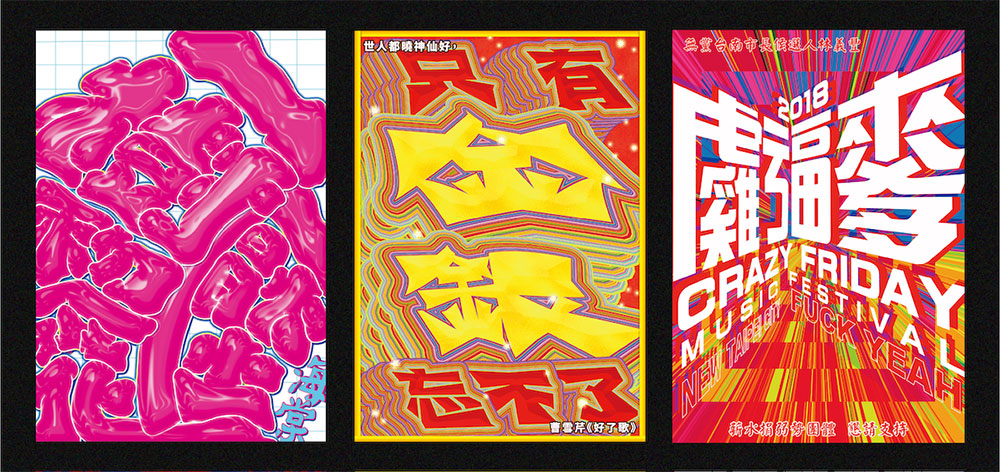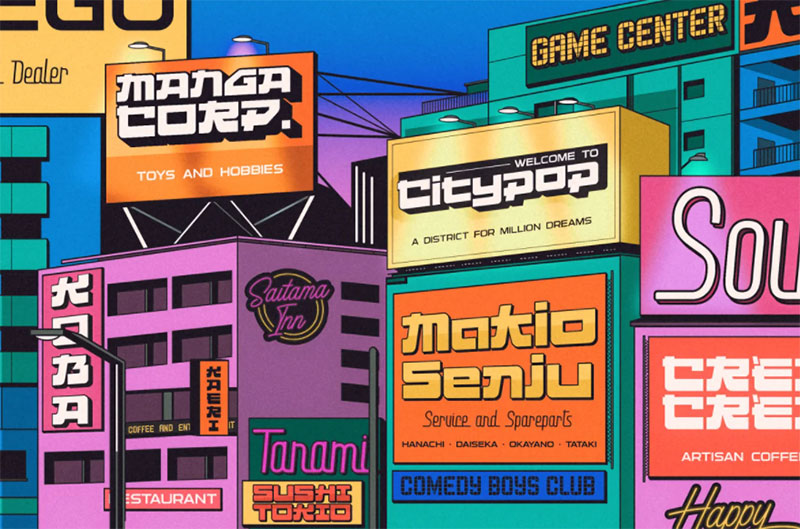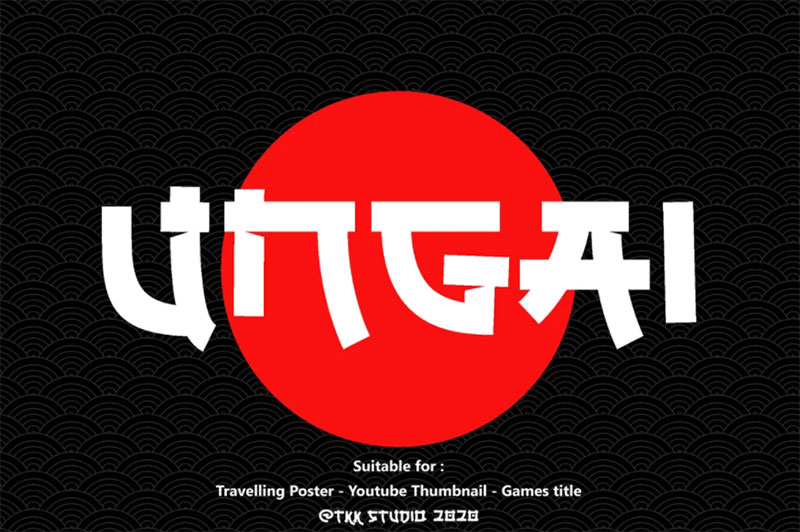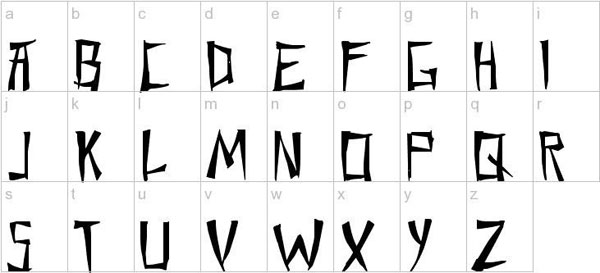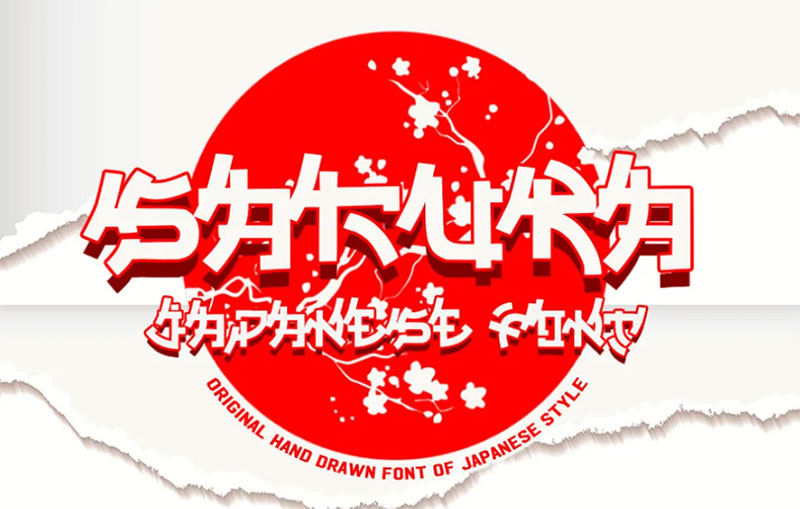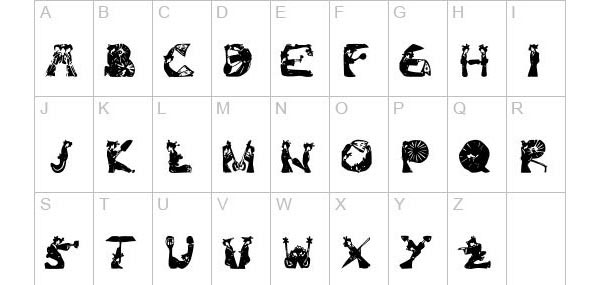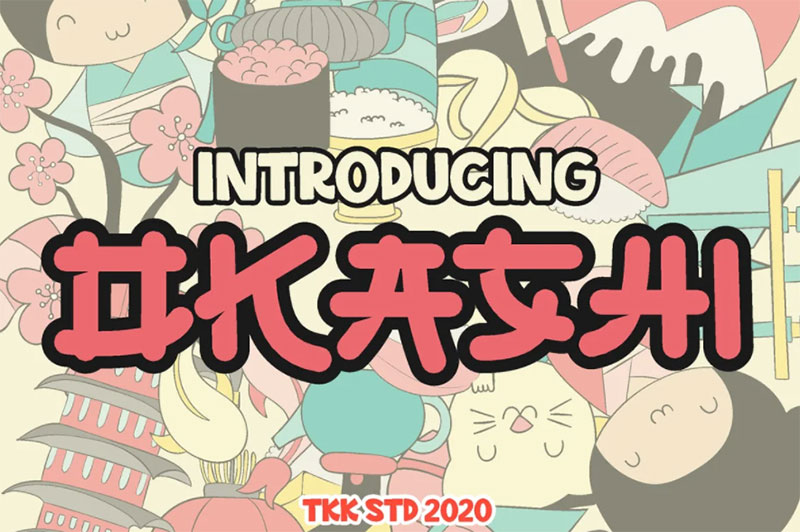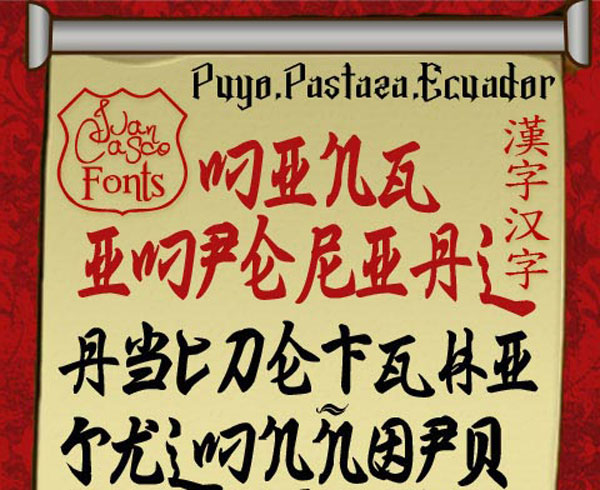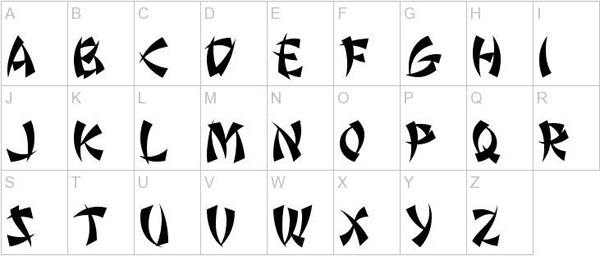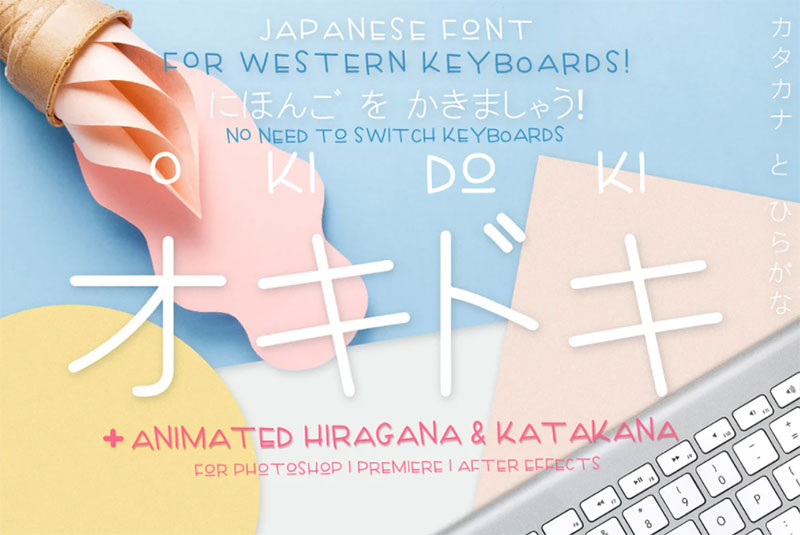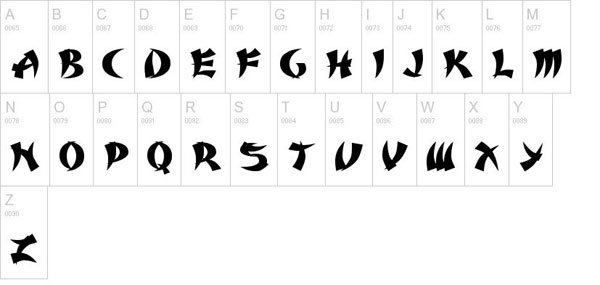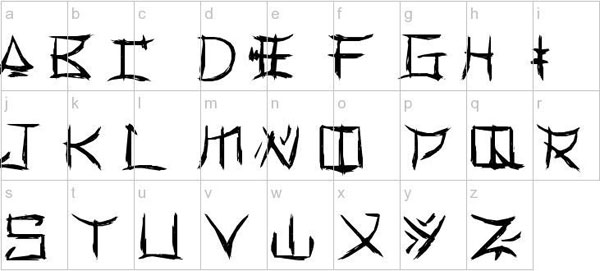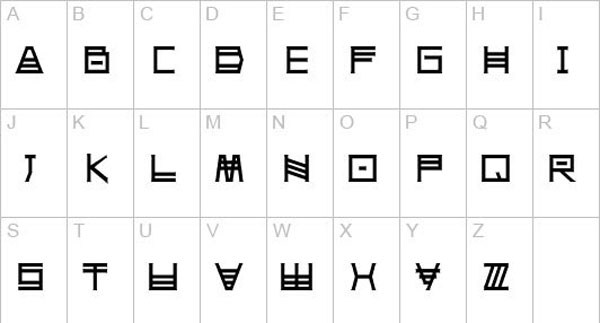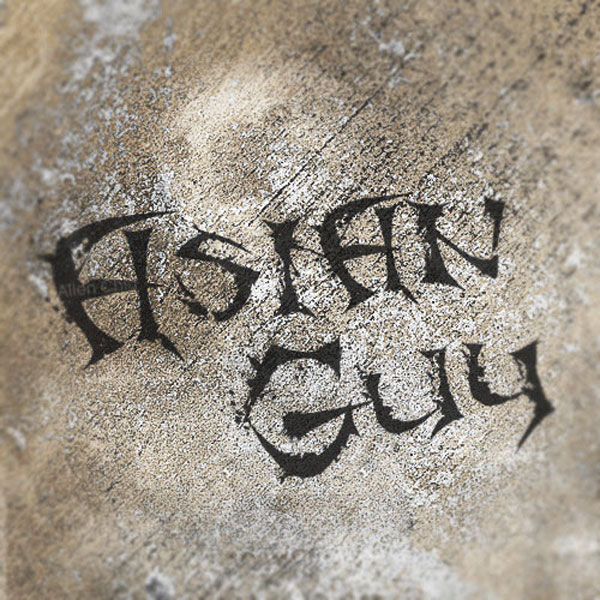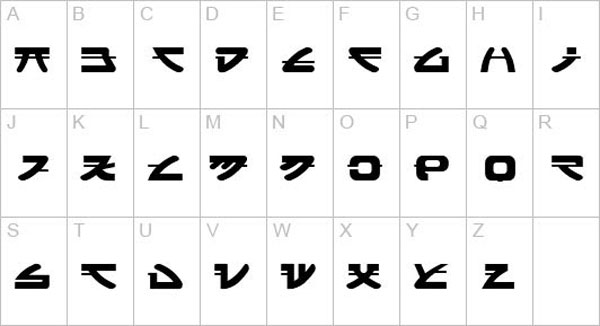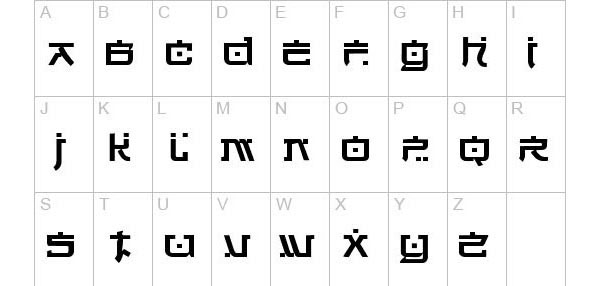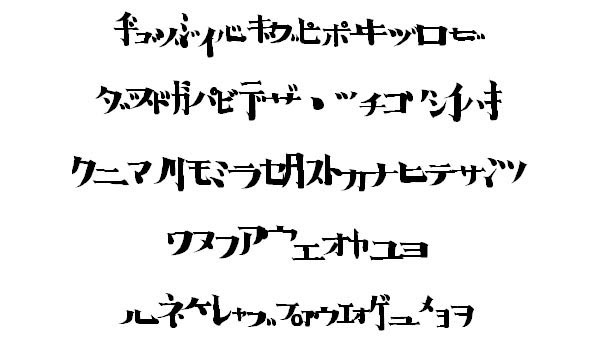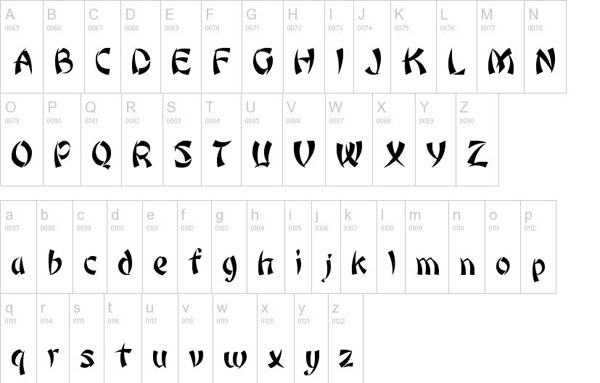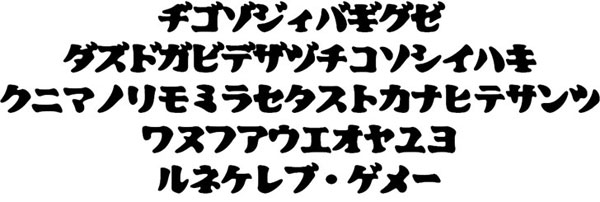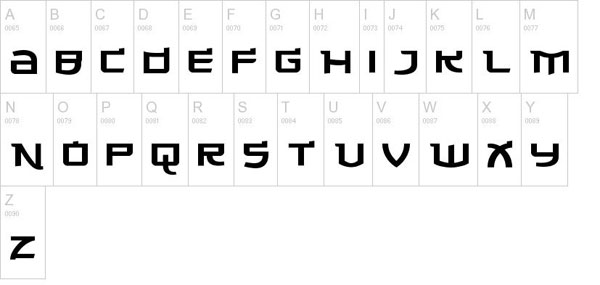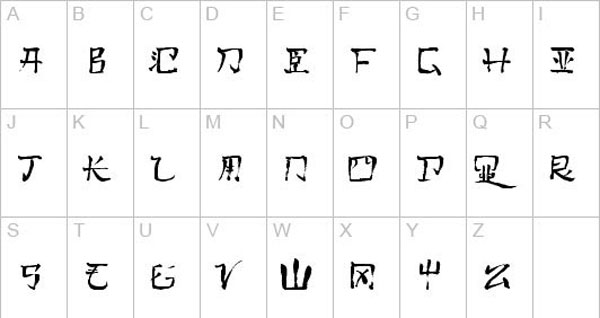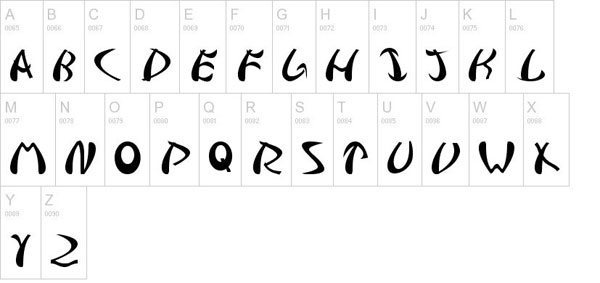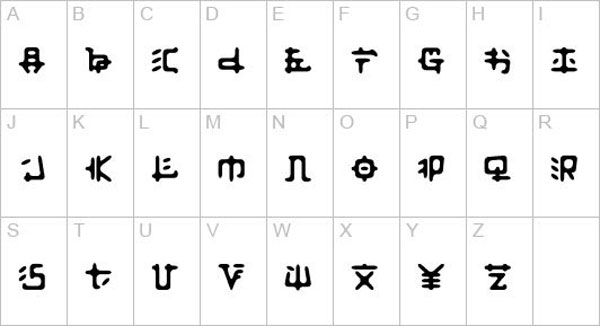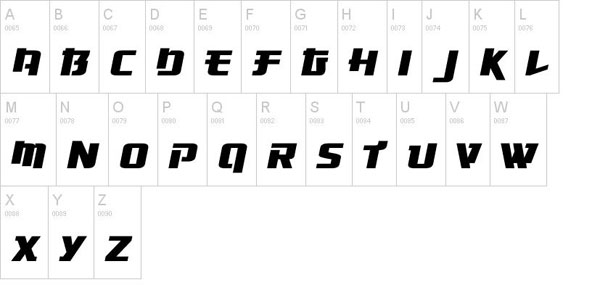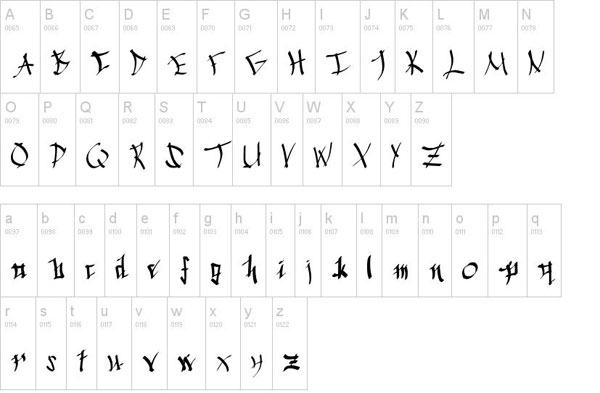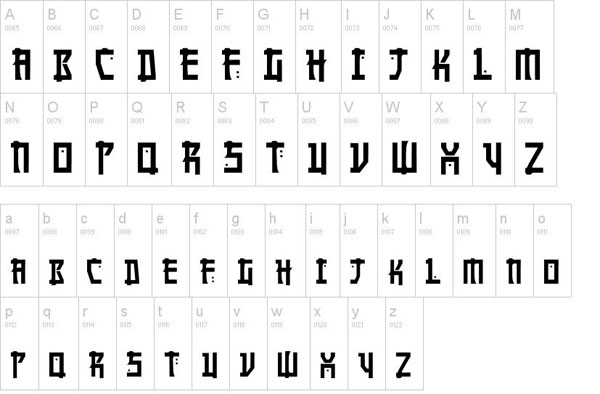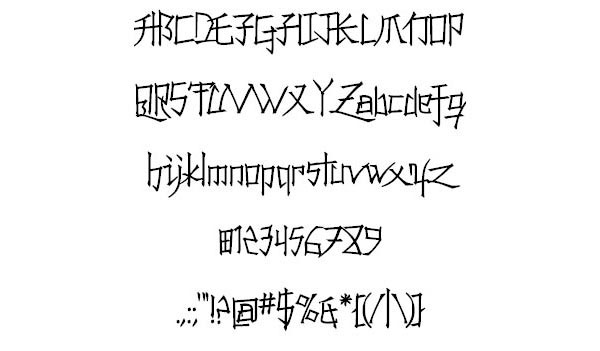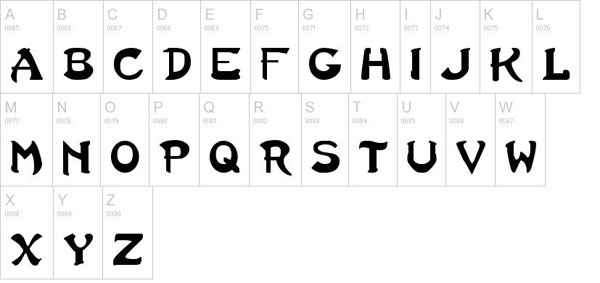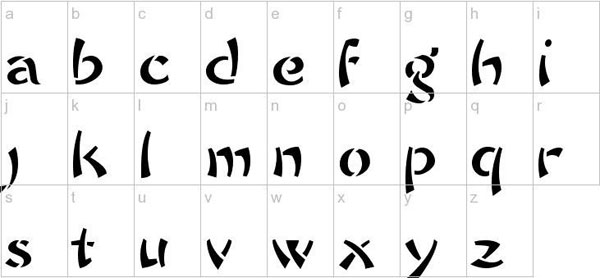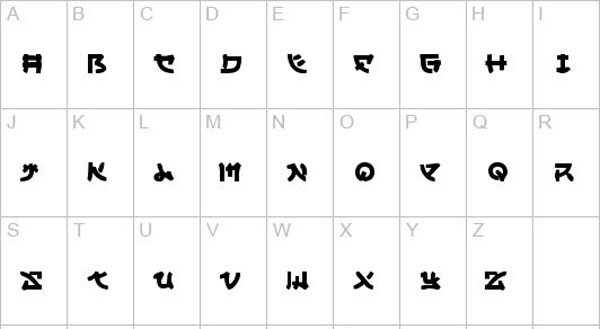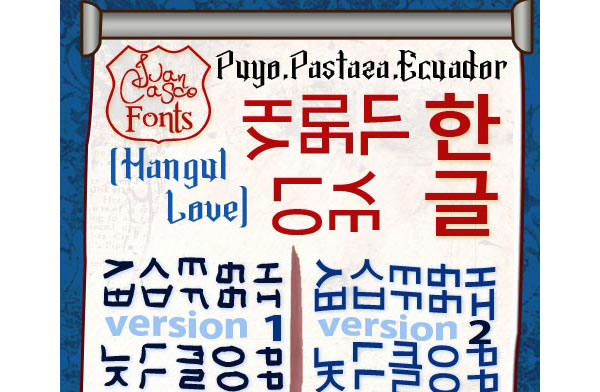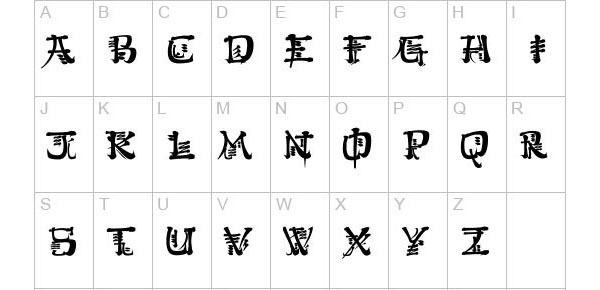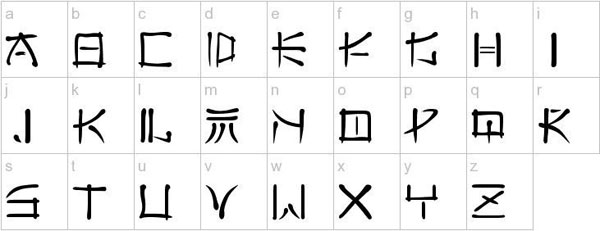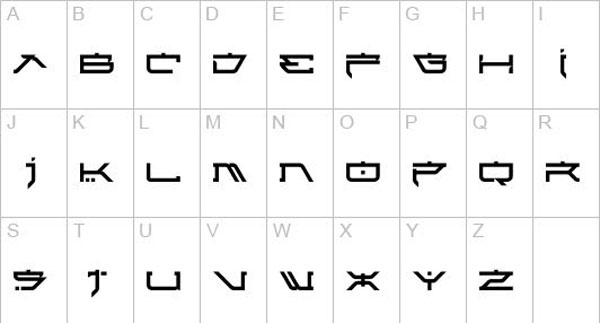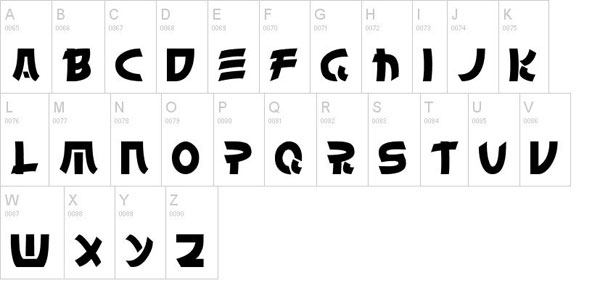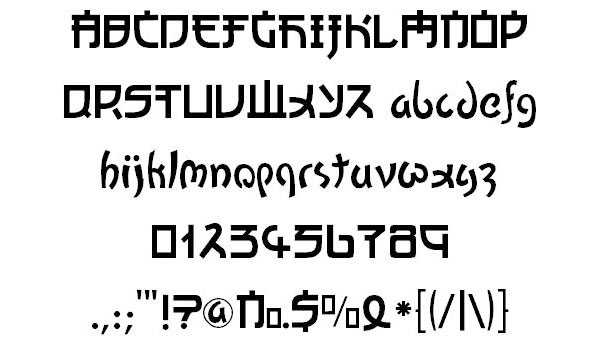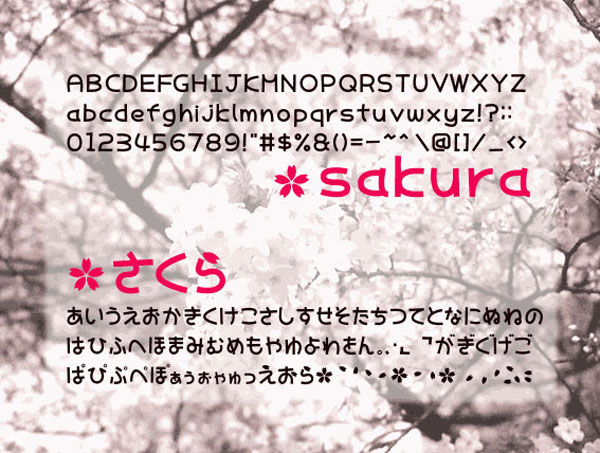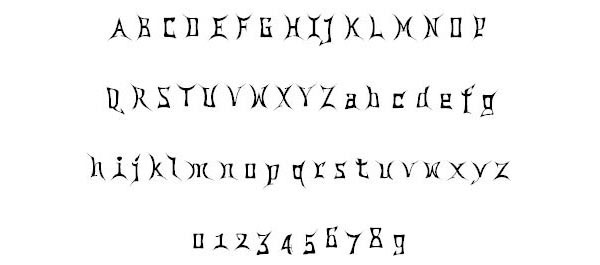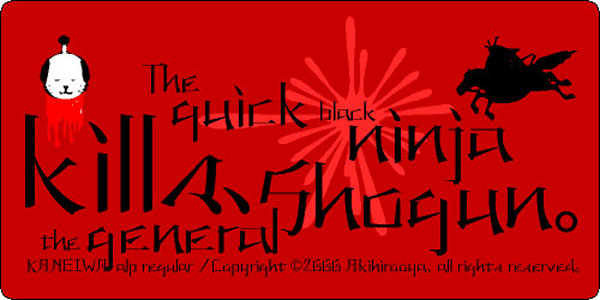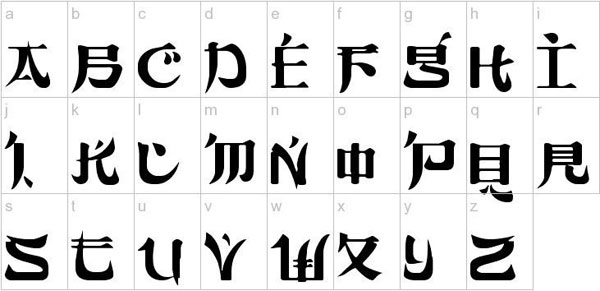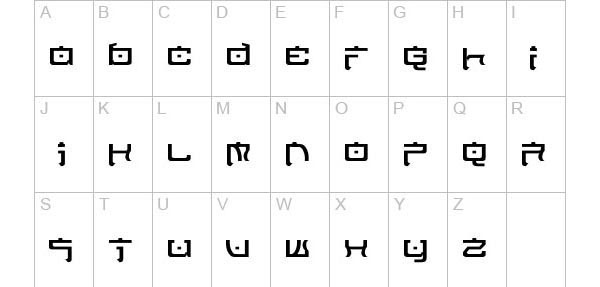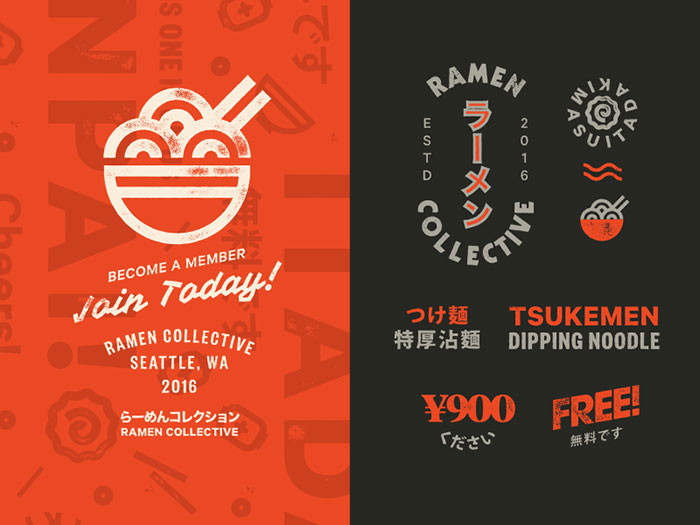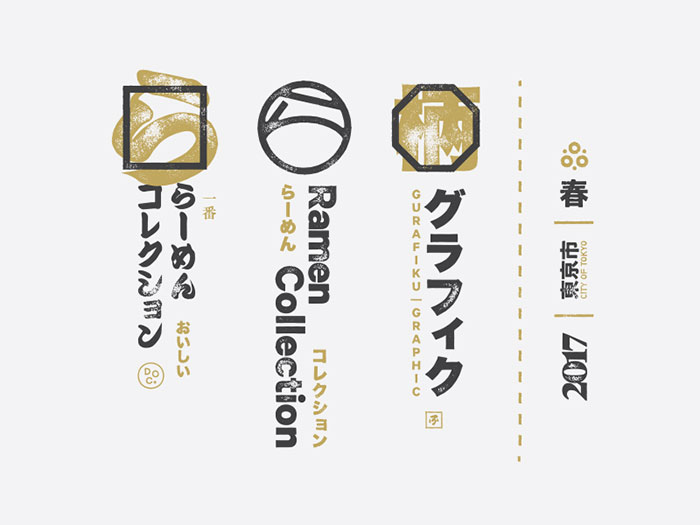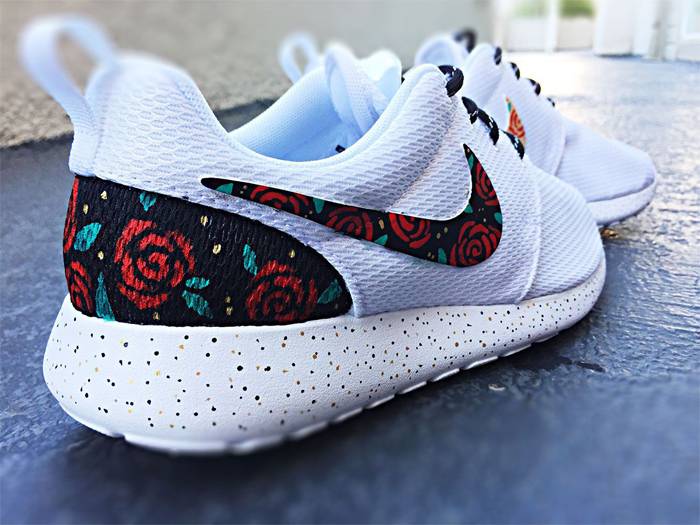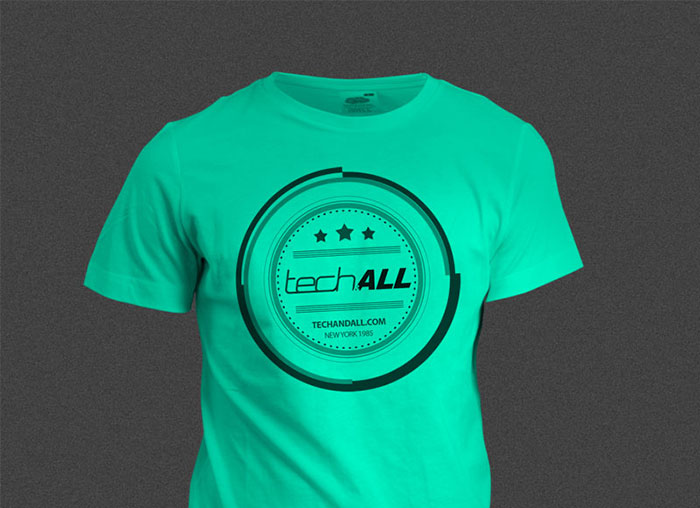Are you looking for Chinese fonts, Japanese fonts, or Korean fonts? There may be some free fonts in this article that are what you need.
Chinese, Japanese, and also Korean fonts have influenced Western designers to create fonts similar to them, borrowing certain letter shapes to give them an oriental look.
In this article, you will find Asian fonts which you can download for free and use in your oriental-themed projects.
Besides these Asian-style fonts, there are in this article actual Chinese or Japanese fonts that you will like.
Chinese, Japanese, and Korean Styled Fonts To Check Out
Scrapbook Chinese
Capital letters:
A=spring, S=summer, D=autumn, }= winter
E=fire, R=water, T=wood, Y=metal/gold, U=ground/earth.
I=north, O=south, P=east, {=west.
Q=sun, W=moon, C=heaven/sky, M=star, F=light.
Lowercase letters:
q=love, w=beautiful, e=happiness, r=friendship, t=smile/laughter, y=kindness, u=grace, o=good/complete, p=luck, a=blessing/fortune, s=peace/safety, d=peace/comfort, f=peace/harmony, g=eternity, h=life, j=birth/life, z=life/destiny, k=health, l=heart/mind (one of my favorites–it looks like a penguin) c=loyalty, m=strength/power
(There’s more, this is just a quick overview.)
CITYPOP – Japanese 90s Retro Fonts
Shanghai
UNGAI – Japanese Style Font
Ungai Japanese font or Jap font took katakana shape, and take it to the modern fast world. With cut out on the inner connection, emphasize the fast and full action world we’re facing. Suit perfectly for Online Games, posters, movie titles, fast food menus, magazines, youtube covers, youtube thumbnails, social media page covers, and so on
Chang and Eng
Korean Calligraphy
This font is based on ‘Hangeul’, the Korean alphabet, and reflects calligraphy typeface. I recommend that you use this Korean calligraphy font if you want to create an oriental mood.
Sakura Japanese style font
Introducing Japanese-style fonts and the only fonts with shapes and styles that exactly resemble the original Japanese characters. but this font is easy to read and can be applied to all media and all can use this font without exception. can be used for clothing, apparel, skateboards, logos, and others.
Gang of Three
Advertisement
Kami-Geisha
OKASHI – Japanese Font
OKASHI Japanese font or Jap font took katakana shape, and take it to the cute cartoon children world. With rounded shape and cut-out on the intersection, emphasize the cuteness but action feel on it.
Ming Imperial
Wonton
Animated Japanese hiragana katakana
Okidoki is a happy font that you can use without switching keyboard language! Simply write in hiragana or katakana and create cool and kawaii graphics.
The best thing? The bundle also contains two animated versions! Choose between a straight and rounded or a wiggle style animation.
Karate
Yonezawa
SheruPro
Asian Guy
Widznipp
Chinese Takeaway
Hirosh
Horror Impact B
Bonzai
Coober Black
Made in China
Pauls Kanji Font Bold
Samurai
Anyong
Osaka Sans Serif
Manglo
Chinese Calligraphy
Manga
Konfuciuz
Last Ninja
Chow Fun
Yama Moto
HaNgUl LoVe2
Kingthings Conundrum
Fareast
Electroharmonix
When I created Electroharmonix 13 years ago, I never dreamed that I’d eventually move to Japan and have to learn to read and write Japanese. Now that I can read this stuff, I can see how badly I mangled those Japanese style fonts. I’ve redrawn everything a little bolder with an attempt to at least sort-of follow the drawing rules of katakana and kanji.
This time there’s no hiragana mixed in; strictly katakana, and a few kanji. Of course, I still had to bend, flip and twist it to try to make it look like an alphabet. I’ve given Electroharmonix better kerning, punctuation, math symbols, fractions and numeric ordinals. There are now 3 types of brackets.
Double smart-quotes have been replaced with Japanese angle quotes. The long dashes have been replaced by double dashes – they resemble a long equal sign. The asterisk is based on the kanji symbol for rice.
The question mark now looks like a plain question mark because, in Japanese, they often use the same question mark we do. The ellipsis is made of dots instead of rings: that’s done on purpose.
This Japanese inspired font includes a license that allows free commercial use: sometimes referred to as a desktop license. This allows you to install the font on a computer and use it to create posters, web graphics, game graphics, t-shirts, videos, signs, logos and more. Read the license agreement for more details on this Japanese free font.
Atari Kids
Chinyen
Kato
Originally conceived as two separate Japanese looking fonts, the upper and lower cases are designed for use separately, but can be mixed when logic and proportion have fallen sloppy dead. Named after Inspector Clouseau’s manservant in the Pink Panther movies.
Seven Monkey Fury BB
SAKURAalp
JSA Lovechinese
China Town
Kaneiwa
Sumdumgoi
Nippon Tech
Learn about Chinese, Korean, and Japanese fonts and typography
Chinese Typography (Chinese Fonts)
If you’re looking at Chinese fonts, how many glyphs will you find in a font set? Will you see free Chinese fonts with sans-serifs and serifs? What is considered to be the Helvetica in the Chinese font world? Let’s take a better look at the field of East Asian typography, and find out.
Why would you care about Chinese fonts?
Web and graphic designers are constantly being asked to make Chinese-language versions of their materials, both the digital ones and the printed ones. You might be in this situation one day, getting calls from such people, so it’s a practical thing to understand Chinese fonts.
If you’re a learner, you’ll find that Chinese text is actually pretty cool. Ask anyone, and they’ll tell you that the Chinese are actually the oldest in-use writing system in the world, and many of the major written languages in East Asia are like branches of written Chinese. However, many of them have evolved into distinct, unique languages, yet retain some of the Chinese characters.
And, last but not least, Chinese is actually pretty to look at. And who doesn’t like to look at pretty things? A Chinese font adds an aesthetic appeal to the design.
Simplified Chinese vs. Traditional Chinese
When Chairman Mao and the Communists rose to power, back in 1949, Mao considered that if he made the language less complex, he would increase the national literacy rates. Therefore, he got a couple of linguists and they got working.
However, at that point, he wasn’t the boss of Taiwan, or Hong Kong, or even Macau, and they decided they wouldn’t do the switch. Instead, they kept the original, traditional Chinese. There were also a lot of immigrant communities and Chinatowns overseas before the new language was released, and they also decided to keep the original, traditional characters. There were therefore many people still writing in an original Chinese style font.
Where will you find Simplified Chinese characters?
- In the official written language of Mainland China, used after 1954-64, anywhere from product packaging to TV subtitles, Chinese type writing uses a simplified font.
Where will you find Traditional Chinese characters?
- In the official, written language in Taiwan, Hong Kong, and Macau the Chinese font style will be traditional.
- In the Chinatowns outside of China, especially overseas the Chinese character font will be traditional.
- On old, antique documents that were written in Mainland China, but before 1954 and Mao Chinese lettering fonts use traditional styles.
- In very formal usage in Mainland China, for example, titles and official place names no simplified Chinese font is used.
- In languages that forked out of Chinese before the simplification, such as Japanese, retro Vietnamese and Korean Chinese style fonts will remain traditional.
So many glyphs
All of that history makes a lot of work for font foundries.
If they want to release professional Chinese letter fonts, they need, first, to create a character set of at least somewhere around 20,000 characters, and then they have to do the same thing again.
One is for Simplified Chinese, and one is for Traditional. And, that’s without taking into consideration all the different weights of the font.
Wait… did you say 20,000?
Yes. 20,000, that’s right. Even despite the simplification, a professional Simplified Chinese font must have around 20,000 glyphs, sometimes a few thousand less, but sometimes a few thousand more. This also includes the English alphabet, both English and Chinese punctuation, as well as a big dictionary of Chinese characters.
You’ll even find Traditional character sets that go up to 30,000 glyphs, or even higher.
Non-professional fonts may try to get away with as few as 2,000 of the most commonly used glyphs, but you shouldn’t use these for base body text, because at one point, you will undoubtedly run into a character you’ll need, but don’t really have. When making a Chinese font download, you will need to take these many glyphs into consideration before making your choice.
What about webfonts and @font-face?
China is still stuck with the original browser standard fonts and SVG/PNG for special type, so they aren’t really on the @font-face boat.
Because their font files have so many glyphs, you’ll find that they go from around 3-7MB per weight, which is a size that defies web embedding.
Only recently, we see extremely experimental technologies such as Youziku and Justfont appearing for non-standard webfont rendering of Chinese characters.
Korean Typography (Korean Fonts)
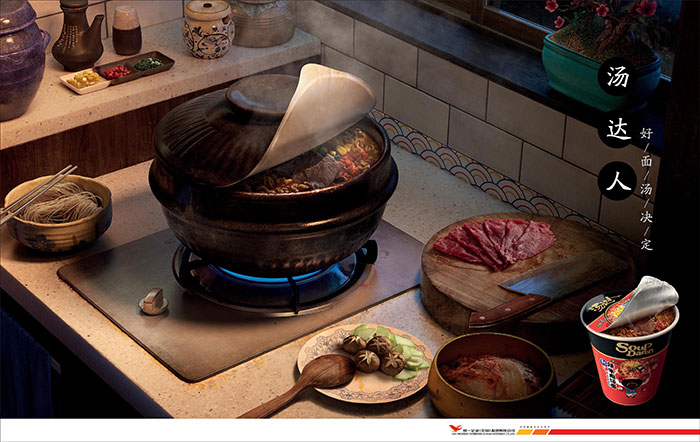
When we’re discussing Korean Typography, and Korean fonts, you’ll find that there are two commonly used writing systems – Hangul fonts, and Hanja .
Hangul was created for the Korean language in the 15th century, and is the syllabic writing system. Hanja actually refers to the Chinese ideograph characters which are used in a typical Korean font, and it’s much less often used than Hangul.
The primary character set found in free Korean fonts, as well as pro ones, is the KSC 5601 standard, with 17,100 characters. The Monotype Korean fonts support both Hangul, as well as Hanja characters, found in the KSC 5601 character set.
Hangul overview
The characters you’ll find in the Hangul Fonts have Hangul characters, Latin alphabetic characters, punctuation marks, as well as numbers and special characters.
The hangul in Korean code ranges found in Unicode usually consist of some precomposed Hangul syllables, as well as the Hangul ‘Jamo’ alphabet.
As far as punctuation goes, you’ll find that CJK Symbols and Punctuation (U+3008~U+300F) are the default ones. However, half-width punctuation is used for horizontal writing, while full-width punctuation is used for vertical writing in this Korean typography.
Japanese Typography (Japanese Fonts)
As far as Japanese typography and Japanese style fonts go, you will find that the Japanese kanji font characters actually use more pixels than an alphanumeric character, because they have many strokes.
For example, ‘A’ as an alphabet character only needs 7×7 pixels, but ‘艦’ as a kanji characters needs 15×15 pixels if you want it to be readable.
This is commonly known for people who make free Japanese fonts and even better known for people that make pro Japanese fonts.
Typography in English comes with parameters such as baseline, cap-height, x-height, and descender height. There are also lower case letters, as well as upper case letters.
However, in Japan style fonts, you’ll find none of these variables. All characters are roughly the same size as the English capital letters, and many of them end up being larger than the alphanumeric characters, even when the font size is kept the same.
Due to the complexity and height, the Japanese web localization often demands a bit larger font sizes, as well as wider letter spacing and line height.
If you want to avoid low legibility, it’s recommended that you go for a minimum of 12px font size, 150% line height, as well as 0.05 letter spacing for the body paragraphs. Of course, these numbers may vary, according to the font family.
The first words you’ll learn in typography are usually Serif and Sans-Serif. Serif is known as “Mincho” in Japanese font style, and Sans-Serif is known as “Gothic”. The Mincho font was first used back in the 15th century in China, during the time of the Ming Dynasty, and was used as a typeface for woodblock printing.
The Gothic Japanese script font, however, first appeared in Japan, somewhere around the 18th or 19th century. According to Toshi Omagari, a typeface designer, Gothic was actually invented based on Blackletter, but nobody actually knows for sure.
Mincho Japanese font styles have characters that come with triangular decorative elements at the ends of the horizontal lines, as well as lines that vary in thickness. Gothic font characters, however, come with uniform line thickness and minimal decorative elements.
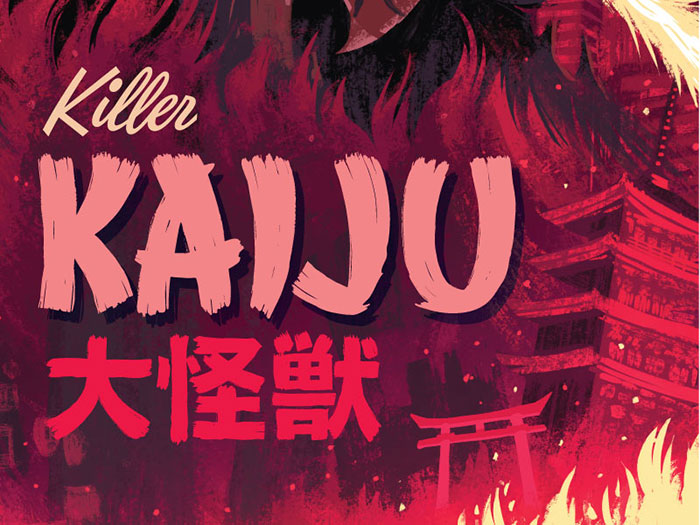
There are also other font categories, such as Kaisho, Reisho, Sosho, handwritten and the Japanese manga font . Mincho and Gothic are commonly used in graphic design and DTP. These are the ones with the most presence as far as web text goes, even though there are many fonts with many purposes.
The best font for Japanese
As far as Japanese script fonts go, you can’t really find the best font. There is only the best choice depending on your priorities, which may include legibility, compatibility, aesthetics, price, brand identity and usability.
This principle also applies to website localization. Making the right font choice in a different language isn’t easy, even for an experience designer.
You’ll find that there are so many available fonts, and it can get overwhelming. This is one of the many functions that a localization expert has when it comes to Japanese style letters.
FAQ about Chinese, Japanese, and Korean style fonts
What’s the difference between Chinese, Japanese, and Korean fonts?
Well, let me tell ya. Chinese fonts tend to be more complex, as they need to accommodate thousands of characters. Japanese fonts are a mix of Chinese characters (kanji) and two syllabaries (hiragana and katakana), while Korean fonts use the Hangul script, which is an alphabet-like system. So, the main difference lies in the writing systems they’re designed for and the visual complexity of each script.
How can I tell which style is which?
Here’s the deal. Chinese characters are generally more complex and intricate. Japanese text often combines kanji with hiragana and katakana, so you’ll see a mix of different characters. Korean Hangul, on the other hand, looks quite distinct, with its circular and angular shapes. If you’re not familiar with these scripts, it can be tricky to tell them apart, but with some practice, you’ll start to notice the differences.
Where can I find these fonts?
Looking for some sweet fonts, huh? You can find Chinese, Japanese, and Korean fonts on various websites, like Google Fonts, Adobe Fonts, or Font Squirrel. They offer a wide range of free and paid fonts suitable for different purposes. Just make sure to check the licensing terms before using them in your projects, especially if it’s for commercial use.
How do I install these fonts on my computer?
No worries, it’s super easy! On Windows, download the font file (usually a .ttf or .otf), right-click on it and select “Install.” On a Mac, double-click the font file and hit “Install Font” in the pop-up window. Voilà, now the font should be available in your text editing and design software. Just remember to restart the program if it was open during the installation.
Are there any design principles specific to these fonts?
Absolutely! Each script has its own unique design principles. For instance, Chinese fonts often focus on maintaining a balance between complex strokes and negative space. Japanese fonts consider the harmony between kanji and syllabaries. Korean fonts emphasize the balance and structure of Hangul. As a designer, it’s essential to understand these principles to create visually appealing and readable text.
How do I choose the right font for my project?
Choosing the right font can be a real game-changer! First, think about the purpose of your project and the vibe you’re going for. Next, consider readability and the size of the text. For instance, some fonts are better suited for headlines, while others work well for body text. Finally, make sure the font you choose supports all the necessary characters for your language.
Can I use the same font for all three languages?
In some cases, you can use a single font that supports all three languages, called “Pan-CJK” fonts. These fonts contain glyphs for Chinese, Japanese, and Korean characters, ensuring consistency across languages. However, not all fonts have this feature, so double-check before using one for a multilingual project.
Are there any popular trends in East Asian font design?
Trends come and go, my friend. In recent years, we’ve seen a rise in minimalist and modern designs, with clean lines and geometric shapes. Additionally, there’s been a resurgence in traditional calligraphy-inspired fonts, which offer a classic and elegant look.
Keep an eye on design blogs and social media to stay updated on the latest trends in font design!
What are some common mistakes when using these fonts?
Here’s the thing: one common mistake is using a font that doesn’t fully support the language, which can lead to missing or incorrect characters. Another pitfall is not respecting the design principles of each script, resulting in poorly balanced or visually unappealing text.
Lastly, some people might stretch, distort, or apply excessive effects to the text, making it difficult to read or appear unprofessional. So, be mindful of these potential issues and always double-check your work!
How can I improve my typography skills for these languages?
You’re on the right track for wanting to improve! First, learn about the basics of typography and the unique design principles for each script. Study high-quality examples of Chinese, Japanese, and Korean typography in books, online resources, or even by observing signage and packaging.
Practice creating your own designs and experiment with different fonts, sizes, and styles. Don’t be afraid to ask for feedback from native speakers or experienced designers. As with any skill, practice makes perfect!
Ending thoughts on Chinese, Japanese, and Korean style fonts
We’ve just taken a deep dive into the world of Chinese, Japanese, and Korean style fonts. I gotta say, it’s been quite a journey exploring these beautiful and unique characters. You know, they really bring a fresh perspective to the table.
- First, we looked at the Chinese fonts:
- Rich history, my friend!
- We saw how intricate they can be.
- Then, we moved on to Japanese fonts:
- Talk about versatility!
- We learned about the different styles and their uses.
- And finally, we delved into Korean fonts:
- Let’s not forget the elegant Hangul.
- We discovered how it’s influenced by its neighbors.
In conclusion, these Asian-inspired fonts are not only a feast for the eyes but also offer designers an opportunity to get creative and add that special something to their projects. So, next time you’re designing a poster, writing a blog post, or crafting a wedding invitation, why not consider giving one of these gorgeous fonts a try? Trust me, you won’t regret it.
If you liked this article about Chinese, Japanese, and Korean style fonts, you should check out this article about the Batman font.
There are also similar articles discussing the Superman font, the Captain America font, the Black Panther font, and the GTA font.
And let’s not forget about articles on the Hulk font, the Call of Duty font, the Apex Legends font, and the Rocket League font.

